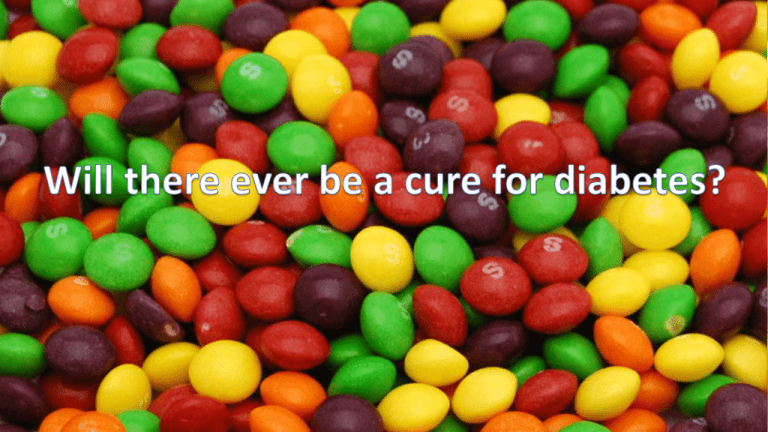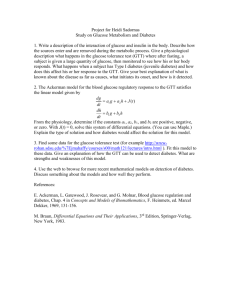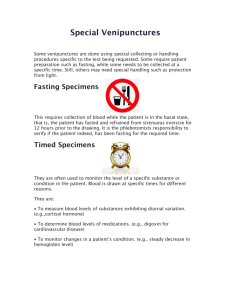Diabetes Research
advertisement

What do we know about diabetes? • There are two types of diabetes type 1 diabetes and type 2 diabetes • Diabetes causes blood sugar to become too high • Untreated diabetes can cause serious complications • In 2010 there were 3.1 million people with diabetes. 15% have type 1 diabetes and around 85% have type 2. • How many people have each type of diabetes? https://www.youtube.com/watch?v=XOowX3OwFuk • Type 1 diabetes3.1 million ÷100 = 0.031 million (<- this is 1%) 0.031million x 15 = (x by 15 to get 15%) 0.465 million or 465,000- ALMOST HALF A MILLION • Type 2 diabetes – 3.1 million ÷100 = 0.031 million 0.031 million x 85 = 2.635 million or 2,635,000 (<- this is 1%) (x by 85 to get 85%) • And research predicts these numbers are rising rapidly. How diabetes is treated Type 1 Diabetes • Onset can be fast • Most diagnosed when young • Insulin dependant – these patients require insulin injections to maintain normal blood sugar Type 2 Diabetes • Onset is slower • Mainly in older and obese people • Can be managed with diet and exercise. There are problems with using insulin injections as a treatment for type 1 diabetes? Could you think of any? - Inconvenient - Treatment not a cure - Not a continuous supply, the body naturally releases insulin in exactly the right amounts when it is required What do scientists measure to see if their diabetes experiments have worked? • This test is the Oral Glucose Tolerance Test (OGTT) • The test measures changes in blood glucose levels after a controlled amount of glucose has been eaten (called a glucose load). • The patient must fast (not eat any food) for 12 hours before the test • Blood sugar is measured at 30 minute intervals for 2 hours https://www.youtube.com/watch?v=rMMpeLLgdgY The data provided is based on human results of the OGTT. The World Health Organisation (WHO) say a person without diabetes should have: • Fasting value (before test): under 6.1 mM and normal values are from 3.9 to 5.5 mM • At 2 hours: under 7.8 mM Are any of the data sets in this group diabetic? Blood Glucose (mM) Oral Glucose Tolerance Test OGTT 0 30 Time (minutes) 60 90 120 Can you label each point on your graph to show what might be happening? Oral Glucose Tolerance test in 4 humans 13 12 11 10 9 8 Blood Glucose (mM) 7 6 5 4 3 2 1 0 0 30 60 Person 1 Person 2 90 Person3 Time (minutes) Person 4 120 Scientists are looking for a cure • Stem Cells – cells with the ability to turn into any cells in the body. • Using stem cells scientists are trying to make pancreas cells which can be transplanted into diabetic patients. • In the end this could offer a cure Gao et al. 2014 Things are not always as straight forward as they seem in the world of science. To compare these graphs we need to convert the units. To convert from mg/dl to mM we must times by 0.0555 Raikwar, S. P. and Zavazava, N. (2011). Things are not always as straight forward as they seem in the world of science. To convert from mg/dl to mM we To compare these graphs must we need to convert times the by 0.0555 units. Raikwar and Zavazava (2011) Time Blood Glucose mg/dl Blood Glucose mM 0 100 5.55 30 210 11.65 60 175 9.71 90 110 6.10 120 115 6.38 Time Blood Glucose mg/dl Blood Glucose mM 0 390 21.64 30 710 39.40 60 825 45.79 90 900 49.95 120 1000 55.5 Time Blood Glucose mg/dl Blood Glucose mM 0 200 11.1 30 310 17.2 60 350 19.42 90 210 11.66 120 195 10.82 OGTT in mice 60 55 50 Compare this graph to the one you have produced for a human OGTT 45 Blood Glucose (mM) 40 35 30 25 20 15 10 5 0 0 30 60 90 Time (minutes) Control Diabetic Treated 120 OGTT in mice Oral Glucose Tolerance test in 4 humans 60 13 55 12 50 11 45 40 9 Blood Glucose (mM) Blood Glucose (mM) 10 8 7 6 35 30 25 5 20 4 15 3 10 2 5 1 0 0 30 60 90 Time (minutes) 0 0 30 Person 1 60 Person 2 Time (minutes) 90 Person3 Person 4 120 Control Diabetic Treated 120 OGTT in mice 60 55 50 45 Blood Glucose (mM) 40 35 Are there many similarities? What are the differences? 30 25 20 Could you think of any reasons for these differences? 15 10 5 0 0 30 60 90 Time (minutes) Control Diabetic Treated 120 What are the benefits of using mice models? What are the drawbacks of using a mouse model to experiment on human disease? References • Raikwar, S. P. and Zavazava, N. (2011). Spontaneous in vivo differentiation of embryonic stem cell-derived pancreatic endodermlike cells corrects hyperglycemia in diabetic mice. Transplantation 91:11. • Gao, X., Song, L., Shen, K., Wang, H., Niu, W., Qin, X. and Qian, M. (2014). Bone marrow mesenchymal stem cells promote the repair of islets from diabetic mice through paracrine actions. Molecular and Cellular Endocrinology 388:41-50. • World Health Organisation. www.who.int/ http://www.who.int/diabetes/action_online/basics/en/index1.html Oral Glucose Tolerance test in 4 humans 13 12 11 10 9 8 Blood Glucose (mM) 7 6 5 4 3 2 1 0 0 30 60 Person 1 Person 2 90 Person3 Time (minutes) Person 4 120






